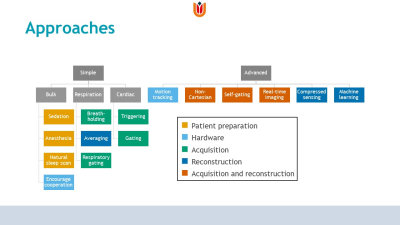Motion Management in Pediatric Cardiac MR
1Radiology and Nuclear Medicine, Amsterdam UMC, location AMC, Amsterdam, Netherlands
Synopsis
Pediatric cardiac patients have high heart rates and fast and often irregular breathing. Aperiodic and sporadic bulk motion is also an issue, especially for very young patients. Mitigation, compensation, or correction of motion is therefore paramount. This educational talk will describe patient preparation, hardware, acquisition, and reconstruction strategies for motion. Simple routine approaches will be discussed, such as: sedation versus general anesthesia and breath-holding versus averaging. More advanced and emerging approaches, which include real-time imaging, resolving cardiorespiratory motion, and the application of machine learning, will also be addressed. Examples from literature and ISMRM will be highlighted to exemplify these approaches.


